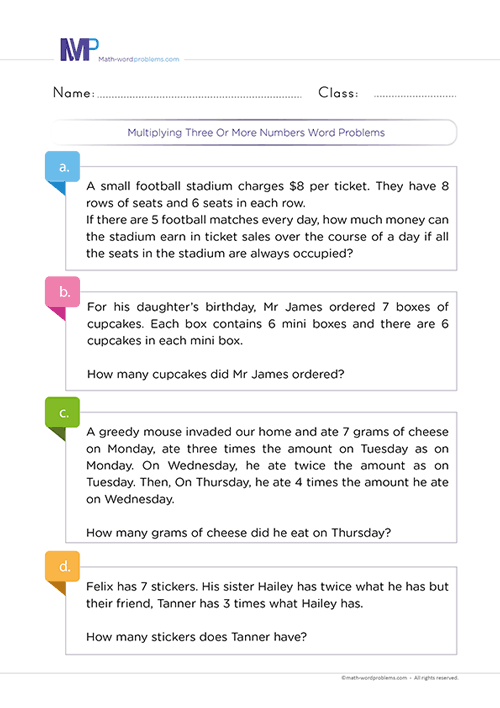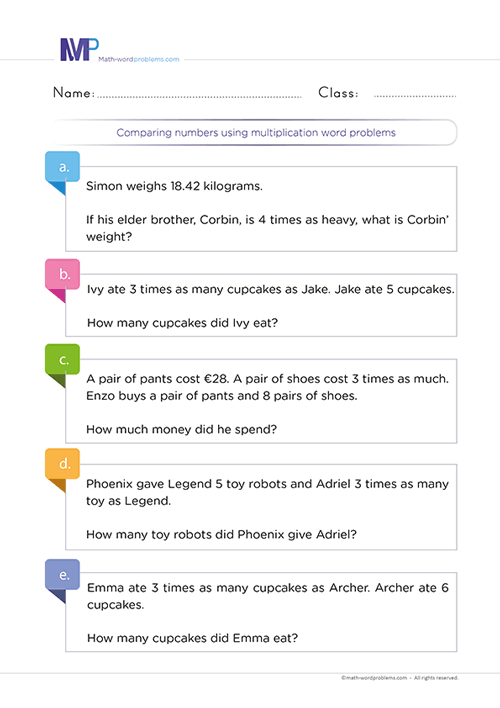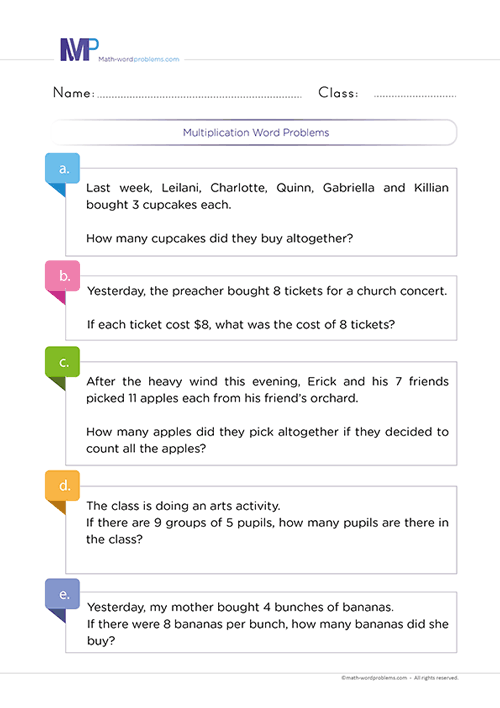 How to multiply three or more numbers word problems
How to multiply three or more numbers word problems

- INTRODUCTION
- Step 1 Identify
- Step 2 STRATEGIZE
- Step 3 SET UP
- Step 4 PROVIDE A SOLUTION
- Step 5 CHECK YOUR WORK
Get more contents on this skill...
Grab the best procedure on how to multiply three or more numbers word problems. This resource will detail the problem schema strategy and emphasize several main features that kids will discover in the course of reading to understand the multiplication of three or more number word problems.
So, after grasping this straightforward procedure of multiplying three or more number word problems, learners' potential in reading, understanding, identifying relevant problem types, and transforming the information in this problem type into a maths sentence will eventually increase.
Steps on how to multiply three or more numbers word problems
Here, we have remarkable steps on how to multiply three or more number word problems that will enable 3rd Graders to brush through any challenging grade 3 multiplication word problems.
In all, they will learn to identify the critical problem features, grasp a mental representation of the problem, and map this mental representation of multiplying three or more number word problems into an efficient solvable maths equation.
To fully engage your kids in multiplying three or more number word problems, we will add challenging but fun real-life examples to show how these steps work.
Step 1 IDENTIFY THE PROBLEM
To identify the problem,
- You can begin by studying/reading out the problem carefully to understand it.
- Then, identify and highlight relative statements.
- Now, reread the problem and try to figure out any important numbers and keywords you can find in the problem.
So, suppose a word problem requires you to perform a multiplication operation. In that case, you will come across one of the following keywords in the word problem: - times, multiplied by, product, the product of, factor, of, multiply, times, multiple, double, triple, groups, by, twice, area, equal groups, every, in all, total, increased by, as much, each, lots of, groups of, per, percent of, the fraction of, earned, etc.
Note: learners should understand that it would be best not to rely entirely on keywords alone because a particular keyword can have different meanings in different word problems.
In that case, you need to read the question very well to understand the situation the word problem describes. After reading, you will also find out if the problem makes sense first before determining which operation you need to use.
Step 2 STRATEGIZE AND DETERMINE THE OPERATIONS
HAs you move on to this step, ask yourself this pertinent question because it helps, “how will I handle this problem?”
Here, you must apply the read-to-understand rule. In this step, you have to read the word problem and try to interpret it in your own words.
Since each word problem may require a different solving format, the key points below will enable you to tackle any word problem irrespective of its format.
- First, the keyword(s) in the word problem will help clarify the operation you need to carry out.
- Relying on keywords alone to solve word problems has some limits, as mentioned in step 1 above.
- So, you must read the word problem to understand the situation that the problem is describing first.
- Reading the problem to understand it will enable you to identify the problem type and relative statements in the word problem, which, together with its keyword(s), will determine the correct maths operation that you need to use
Step 3 SET UP A NUMBER SENTENCE AND AN EQUATION
- Now, after knowing which operation you will perform from step 2 above, construct short sentences to represent the information given word problem.
- These short sentences represent the vital information that makes it easier to solve the word problem. In order words, it is like a diagram of the word problem.
- After that, you can now deuce a solvable maths equation to represent the information given in the sentences that you constructed above
Step 4 SOLVE THE PROBLEM
Next, after writing down the maths equation, you can multiply the numbers using regrouping or other methods like long multiplication, grid multiplication, or lattice to determine the result. Remember always to include the unit of measurement in your final answer.
Step 5 VERIFY YOUR ANSWER
Finally, check your work to make sure that your answer is correct. For instance, since you are dealing with only numbers and not algebraic expressions, it is good to use reasonableness by estimation to see if your answer makes sense.
Therefore, if you estimate and the answer is close to what you have, your answer is correct. However, if your answer is beyond reasonable limits, you must go back to step one and start again.
Examples of how to solve multiplication of three or more numbers word problems.
Example One
Step 1:Start by reading the problem and underlining all the relational statements that you will find. So, after reading the problem very well, the important numbers you will find in the word problem, for now, are $9 and 7. Also, the keyword found in the word problem are “per” and “earn.”
Step 2: Now, the question is, "how will you solve this problem?"
Now, we have to construct short sentences to represent the given word problem.
You need to reread the problem and interpret it in your own words to come out with the correct operation without necessarily depending on the keyword.
The problem is trying to say that Jude spends a certain number of hours in a restaurant working as a waitress every day. After every hour, he gets paid a certain amount of money.
Now, the problem wants you to determine how much she will make in a week.
At this moment, you should ask yourself, “which operation can I use to find the number of equal-sized groups and the number of items/things in each group?”
Back to the given problem, in this particular question, you have to deal with two different equal-sized groups:
- In the first part, the number of equal-sized groups is the given number of hours that Jude works per day, and the number of things in each group is the amount of money he earns per hour.
- Then in the second part, the number of equal-sized groups is the total amount of money he earns per day, and the number of things in each group is the amount of money that he will earn in the given number of days ( a week = 7 days).
So, you see that, from the situation that the problem is describing, from retelling the problem in your own words, and from the keyword equally found in the word problem, it shows that you have to perform a multiplication operation.
Step 3:Next, construct short sentences representing the most vital information in the word problem.
After that, translate the bolded sentence below into an accurate solvable math equation.
- Amount of money she earns per hour = $9.
- Number of hours she works per day = 7.
- Number of days in a week = 7.
- Therefore, the amount of money she earns in a week = the amount she earns per hour × the number of hours she works per day × the number of days in a week.
→ $9 x 7 x 7 = ?
Step 4: From step 3 above, stack the values in the equation you formed, so their place values line up. Then, go ahead and add the values using any method of subtraction, preferably the column method. Also, add the unit of measurement to the final result.
So, she earns $441 a week.
Step 5: Finally, check your work to ensure your answer is correct. Since you are dealing with only numbers and not algebraic expressions, it is good to use reasonableness by estimation to see if your answer makes sense.
If you estimate and the answer is close to the one you have, then your answer is correct. However, if your answer is beyond reasonable limits, you must go back to step one and start again.
Example two:
Step 1:Read the problem and underline all the relational statements. After reading the problem, you see that the important numbers you will find are $9, 8, 9, 3, and 8. Also, the keywords that you will find in the word problem are “earn” and “how much.”
Step 2:Now, the question is, "how will you solve this problem?"
Reread the problem and retell it in your own words to come out with the correct operation without necessarily depending on the keyword.
The interpretation of the problem goes thus: - In a particular football stadium, a certain number of matches are being played daily. To watch a match in this stadium, you must pay a ticket that costs a certain amount. Also, the stadium has a certain number of rows, and there are a certain number of seats per row.
Now, the problem wants you to find the amount of money the stadium will make from the tickets they sell for specific days, considering that all the stadium seats are always occupied.
So, which operation can you use to find the number of equal-sized groups and the number of items/things in each group?
Back to the given problem, in this particular question, you have to deal with more than two different equal-sized groups:
- In the first part, the number of equal-sized groups is the number of rows of seats in the stadium, and the number of things in each group is the number of seats per row.
- Then in the second part, the number of equal-sized groups is the total number of seats in the stadium, and the number of items in each group is the cost of one ticket per match.
- Next, in the third part, the number of equal-sized groups is the total amount of money made from ticket sales per match, and the number of things in each group is the number of matches per day.
- In the final part, the number of equal-sized groups is the total amount of money made from ticket sales from the given number of matches per day, and the number of items in each group is the number of the given days.
So, you see that, from the situation that the problem is describing, from retelling the problem in your own words, and from the keywords found in the word problem, you have to perform a multiplication operation.
Step 3: Next, construct short sentences representing the most vital information in the word problem.
After that, translate the sentence that is in bold below into an accurate solvable math equation.
- Cost of one ticket = $9,
- Number of rows of seats = 8,
- Number of seats in each row = 9,
- Number of days = 8
- Number of matches per day = 3,
- Therefore, the amount of money earned in ticket sales over 8 days = the cost of one ticket × the number of rows of seats × the number of seats in each row × the number of days × the number of matches per day;
→ 8 × 9 × $9 × 3 × 8 =?
Step 4: From step 3 above, multiply the numbers using regrouping or any other multiplication methods like long multiplication, grid multiplication, and lattice method to determine the result. Always include the unit of measurement in your final answer.
Using Using the long multiplication method, we have
SSo, the stadium will make $15,552
Step 5:Finally, check your work to ensure your answer is correct. Since you are dealing with only numbers and not algebraic expressions, it is good to use reasonableness by estimation to see if your answer makes sense.
So, if you estimate and the answer is close to the one you have, then your answer is correct. However, if your answer is beyond reasonable limits, you must go back to step one and start again.





